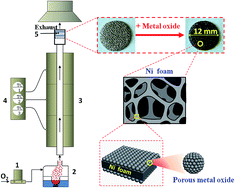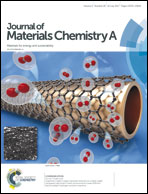A new design concept for preparing nickel-foam-supported metal oxide microspheres with superior electrochemical properties†
Abstract
Herein, we introduced a new design concept for fabricating nickel-foam-supported metal oxide microsphere as an anode for lithium-ion batteries (LIBs). Porous metal oxide microspheres were synthesized via spray pyrolysis. A piece of nickel foam was placed at the exit of the reactor to filter the off-gas and thus to obtain the metal oxide powders. A thin layer of porous metal oxide microspheres was uniformly deposited on the nickel foam within ∼20 minutes. The nickel-foam-supported metal oxide microsphere was directly used as a binder-free anode for the LIBs. The electrochemical properties of the nickel-foam-supported Co3O4 microsphere (prepared as the first target material) were investigated. The as-prepared anode retains a reversible capacity of 1085 mA h g−1 after 180 cycles. More strikingly, it manifests excellent rate performance with a capacity of 555 mA h g−1 even at 3200 mA g−1. Compared to the available methods that are typically time-consuming and complicated, this smart strategy described herein is efficient and simple. It is strongly envisioned that this elegant design concept holds great potential for the efficient synthesis of other nickel-foam-supported metal oxides as electrodes for LIBs or supercapacitors.



 Please wait while we load your content...
Please wait while we load your content...